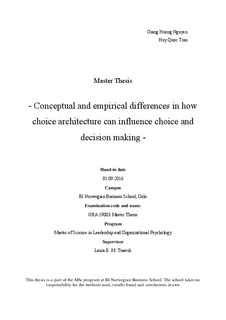| dc.description.abstract | Research shows that people may not always make decisions rationally
but may rely on intuitive judgement and associative memories (Morewedge &
Kahneman, 2010, p. 435). From this perspective, biases and heuristics can
emerge, and decision quality may be dampened (Kahneman & Klein, 2009, p.
515). However, recent research (Besedes, Deck, Sarangi, & Shor, 2014;
Leonard, 2008; Sproull & Kiesler, 1986) has shown that choice architecture,
altering the context in which choices are made, may improve individual and
organizational decision-making. In this thesis, we conduct two studies,
investigate whether choice architecture (specifically presentation order and
indirect messages) may influence peoples’ decisions in certain organizational
settings, and discuss possible important implications of the findings for
organizations.
In the first study, we find that choice architecture in the form of
presentation order and indirect messages can unconsciously increase the healthy
food choices. In the second study, we find that indirect message such as
emoticon can partially increase the participants’ intention to engage in
Organizational Citizenship Behavior targeting Individual (OCB-I). We argue
that such relatively simple, low cost and no intrusive choice architecture has
many potentials for the organizational application.
We, nevertheless, acknowledge that there are several weaknesses with our approaches within the two studies. In particular, the setting of the first study
does not allow us to document demographic information of participants, which
may weaken our choice of control variables (for example, education level of
participants and personal BMI). In the second study, participants are required to
understand certain terms, which they may in fact not, potentially biasing their
answering. However, we argue that our findings may lend some strength to
theories and previous research, suggesting that choice context may be able to
influence decisions in fundamental ways through effects of priming, salience,
and social norm influence, which are described in literature. Furthermore, our
findings may strengthen the case that relatively simple, low cost and nonintrusive
choice architecture approaches have interesting potentials for
organizational applications The main contribution of this paper is, therefore, to provide empirical support for the trend of using choice architecture to influence
decisions and eventually to benefit individuals' well-being and as well as
organizations'. Further research may include the interacting effect of other
potential influencing factors such as pricing (free vs. charge cafeteria),
personality (level of altruism), or cultural contexts (individualism or
collectivism etc.) on the relationship between choice architecture and decisions. | nb_NO |
